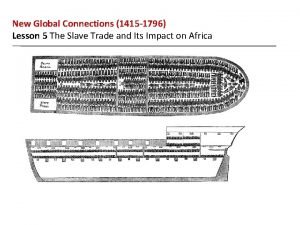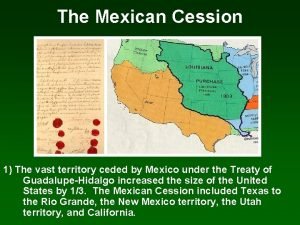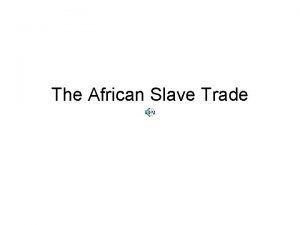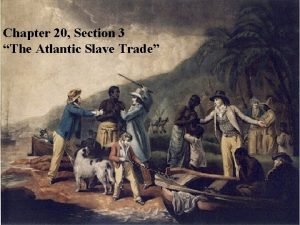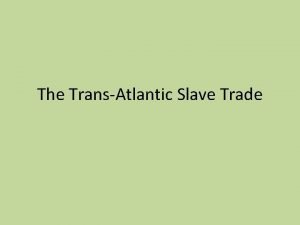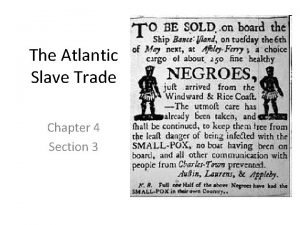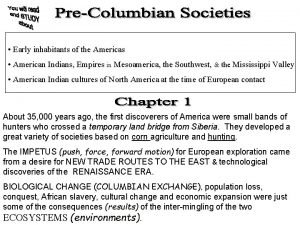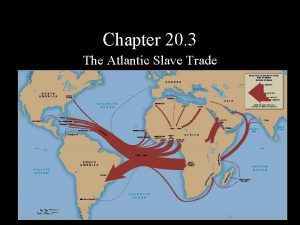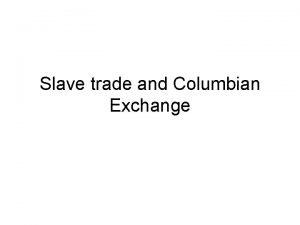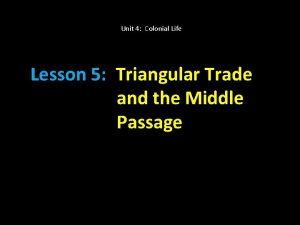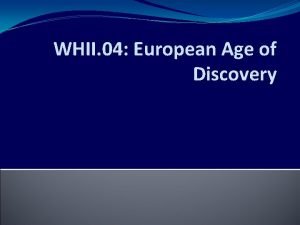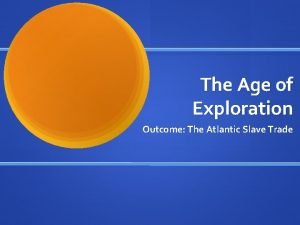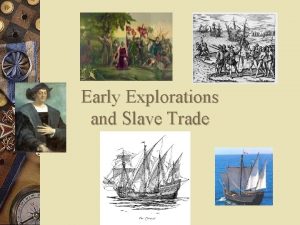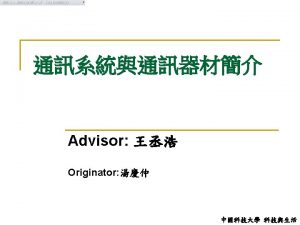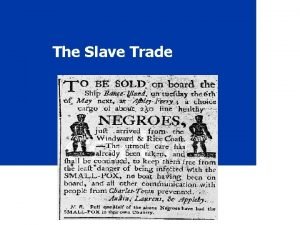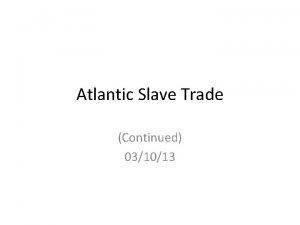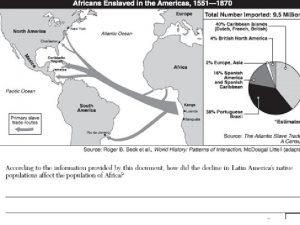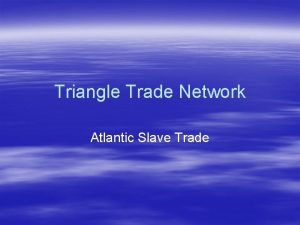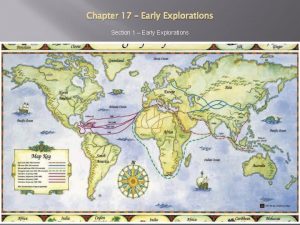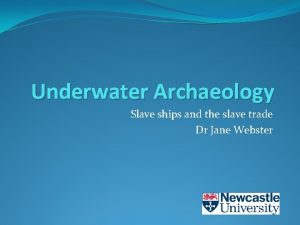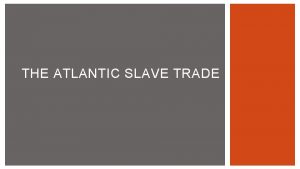Early Explorations and Slave Trade Early explorations w













- Slides: 13

Early Explorations and Slave Trade

Early explorations w In the 1400 s European explorers set off into uncharted oceans in search of a better trade route to Asia. w Explorers hoped for gold, glory and to spread Christianity. w Europe in 1300 s craved spices from Asia such as pepper, cinnamon and nutmeg. The spices were used to flavor and preserve meat and also were used for perfumes, cosmetics and medicine.

New Technology brings long distance Sea Travel! w Open water ocean sailing required new tools so that ships could travel beyond sight of land for extended periods w Sailors began to learn how to use the position of the sun and stars to navigate beyond sight of land, often with help of the following:

w Compass: introduced in late 1100 s, Compass (invented in China) used to determine direction a ship was sailing w Mariner’s Astrolabe: early 1100 s, used to determine the latitude of a ship at sea by measuring the noon altitude of the Sun or the meridian altitude of a star of known declination.

w Cartographer’s (Mapmakers)skills improved into the 1300 s. Mediterranean coastline more accurately mapped w Navigation maps by the ancient Greek astronomer Ptolemy reappear in Europe w Mapmakers use his grid system of latitude and longitude lines on their own maps of the 1300 s.

w Ship design improves in 1400 s: triangle shaped lateen sails added, (could now sail against the wind); multiple masts and sails(3 -4) added made travel faster. w Moved rudder from side to back adding to maneuverability. w New ships called caravels incorporated all these improvements, length: 65 ft. , 130 tons of cargo cap. ; shallow draft allowed it to sail into rivers and up to beaches for easy repair.

Portugal at the Helm w Early 1420 s: Prince Henry the Navigator, son of Portugal’s King John I, brought together the best mapmakers, mathematicians, astronomers to study navigation. w Sponsored many exploratory voyages westward out into the Atlantic and southward down the coast of Africa. w 1488: Bartholomeu Dias found southern tip of Africa (Cape of Good Hope) proved ships could reach East Asia by going around Africa w 1497: Vasco da Gama sailed from Portugal to India, found potential amazing silk and spice trade opportunities in Calcutta, proved a water route was open to the East, became national hero

Spain’s Quest for Riches w Late 1400 s: United under King Ferdinand Queen Isabella after internal war against the Muslim Moors who had occupied Spain w 1492: Columbus approached Isabella for cash to pay for an expedition to find a faster (and thus more profitable) route to the riches of India w Columbus leaves with three ships, lands weeks later in Bahamas, he believes he found India, names inhabitants “Indians” (Islands became know as West Indies) he orders the peaceful locals to bring him gold.

w Columbus dies in 1506, certain he had found new route to Asia… w 1507: Amerigo Vespucci explores Indies and American coastline and suggests Columbus had actually discovered a new world. (maps begin calling new lands America in his honor.

Voyage of Magellan w 1519: Ferdinand Magellan, Portuguese soldier of fortune set sail to find Westward route to Asia, expedition sponsored by Spain w 5 ships head out from port of Seville, cross the Atlantic, head down the coast of South America, w Sail around bottom tip of South America and through the tricky and soon to be named “Strait of Magellan” One ship turns back in storms, one is lost, three others continue out into the Pacific. w (Strait: is a narrow, navigable channel of water that connects two larger navigable bodies of water)

w Magellan himself is killed by hostile natives in the Philippine Islands w Final ship left returns to Seville Spain in 1522 with only 18 survivors! w Completes the first circumnavigation (or circling) of the globe w Proves the world is round and much larger than anyone expected.

The Slave Trade w Slavery had been practiced in Africa since ancient times. Southeast Asia was the primary market for slaves. Here they were used as domestic servants. w The discovery of the Americas (1490 s) led to a dramatic increase in the demand for slaves. w 16 th century plantations – large agricultural estates were growing sugar cane, a very labor intensive crop. Brazilian, Central Caribbean, and African slaves were used on these plantations.

w 1518 – First Spanish ship brings slaves from Africa to the Americas. Slave trade grows dramatically over next 200 years. w Triangular Trade System- European ships carried manufactured goods to Africa where they traded for slaves. Slaves were shipped to Americas and sold. Tobacco, molasses, sugar and raw cotton were bought and shipped back to Europe. w The journey from Africa to Americas was the Middle Passage.
 Ted talk slave trade
Ted talk slave trade Lesson 5 the slave trade and its impact on africa
Lesson 5 the slave trade and its impact on africa Washington dc slave trade
Washington dc slave trade Atlantic slave trade
Atlantic slave trade Chapter 20 section 3 the atlantic slave trade answer key
Chapter 20 section 3 the atlantic slave trade answer key Transatlantic slave trade pictures
Transatlantic slave trade pictures Chapter 4 section 3 the atlantic slave trade
Chapter 4 section 3 the atlantic slave trade Effects of the slave trade on africa
Effects of the slave trade on africa The atlantic slave trade chapter 20 section 3
The atlantic slave trade chapter 20 section 3 Transatlantic slave trade apush
Transatlantic slave trade apush The transatlantic slave trade
The transatlantic slave trade Slave trade primary sources
Slave trade primary sources Destination america
Destination america The age of exploration outcome the atlantic slave trade
The age of exploration outcome the atlantic slave trade

